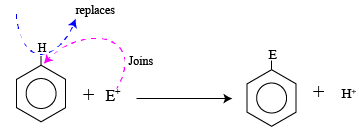Electrophilic substitution reaction
- Posted by Chemistry instructor
- Date April 6, 2021
- Comments 0 comment
Electrophilic Substitution Reaction
Table of Contents
The Learning Objective of the post is
- What is Electrophilic Substitution Reaction?
- Why Arenes undergo electrophilic substitution Reaction?
What is Substitution Reaction?
In substitution reaction, one of the groups is replaced by another group. Below is a schematic representation of the substitution reaction.
Electrophile attack:

Conditions for Electrophilic substitution reaction:
Electrophilic substitution reaction occurs on aromatic rings, because there is a delocalized π-electron cloud on aromatic compounds. Due to de-localization, each carbon atom in the aromatic ring has higher electron density as compared to the carbon atom on an aliphatic compound.
An electrophile is the positively charged species that is it is attracted towards electrons or an element that has higher electron density.
Higher Electron Density on Arene carbon atom:
Aromatic compounds as discussed, have higher electron density than carbon atoms of aliphatic compounds. So aromatic compounds show electrophilic substitution reactions.
Electrophilic substitution Reaction:
In this reaction, the first step is the formation of electrophile, the reagent undergoes heterolytic fission to form an electrophile.
![]()
The formed electrophile attacks the aromatic compound and correspondingly the intermediate is resonance stabilized.
General mechanism for electrophilic substitution reaction
when electrophile joins the benzene ring three resonating structures are produced as all the carbon atoms of benzene are sp2 hybridized and there is a pi bond between carbon atoms, so these pi bonds contribute to the resonance stabilization of the carbocation or carbonium ion formed. The stability of carbonium ion is dependent on two criteria, the first type of carbonium ion and the second number of resonating forms. In this case, a secondary company mind is formed in all the structures because every resonating from the carbonium ion is bonded to 2 different carbon atoms in the benzene ring but there are three different facility forms and they are contributing structures for the stability of carbonium ion.
Resonance Stabilization:

The resonance hybrid structure for the resonating forms of carbonium and in the benzene ring can be shown as
this is the rate-determining step and it is purely dependent on the stability of the carbonium ion
in the final step the carbon atom of the carbonium ion displaces the hydrogen and substituted benzene is formed as the final product. This displacement occurs because hydrogen is less electronegative than a carbon atom, carbon withdraws electrons and stabilizes itself and hydronium ion is displaced.
Types of Electrophilic Substitution Reactions:
There are different types of electrophilic substitution reactions possible in the aromatic compounds they are
Chlorination reaction:
By this reaction, chlorine is introduced into the aromatic ring to form chloro derivative of the aromatic compound is formed for example chlorination of benzene, chlorination of toluene etc.
Nitration reaction:
By this reaction, the nitro group is introduced into the aromatic ring and a nitro derivative of an aromatic compound is formed for example nitrogen of benzene, nitration of toluene, etc.
Sulphonation reaction:
By this reaction, Sulpho (SO3H) group is introduced into the aromatic ring and the sulpho derivative of the aromatic compound is formed for example sulphonation of benzene, sulphonation of toluene, etc.
Friedel crafts alkylation reaction:
By this reaction, an alkyl group is introduced onto the aromatic ring and an Alkyl derivative of the aromatic compound is formed for example alkylation of benzene, alkylation of naphthalene, etc.
Friedel crafts acylation reaction:
By this reaction, an acyl group is introduced onto the aromatic ring and the acyl derivative of the aromatic compound is formed. For example acylation of benzene, acylation of Naphthalene, etc.
Di substitution reaction: by this reaction a monosubstituted aromatic compound is again subjected to any of the above-mentioned reactions to form a disubstituted aromatic compound. For example, chlorination of nitrobenzene, nitration of anisole.
Thanks for reading
You May Like:
Tag:CBSE
ABOUT INSTRUCTOR
B.Sc (honors) Chemistry, M.Sc. (Organic Chemistry), Gold Medalist from Gujarat University Ahmedabad. Passionate educator, helping aspirants for IIT-JEE, NEET-UG, AP-Chemistry, IB-HL Chemistry, BIT-SAT, CBSE, and ICSE to achieve their ambitions
You may also like
Analysis of Ammonium Sulphate
Analysis of Ammonium Sulphate Ammonium Sulphate Chemical Composition: Ammonium sulphate, a colorless crystal solid with the chemical formula (NH₄)₂ SO₄, has a rich history and …
Acid catalyzed dehydration of alcohols
Acid catalyzed dehydration of alcohols Cracking Organic Chemistry: Top 5 Tips to Master Acid Catalyzed Dehydration of Alcohols. A blog post that provides valuable insights …
Cracking BITSAT: Expert Tips and Strategies to Ace the Exam “Cracking BITSAT: Expert Tips and Strategies to Ace the Exam” – A blog post that …

